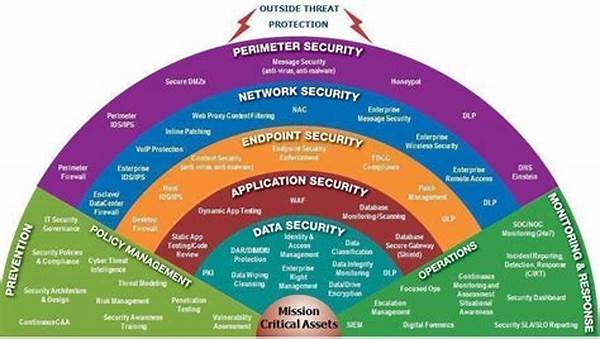In today’s world, security is not just an option—it’s a necessity. With the ever-increasing threats from cyber-attacks to physical security breaches, having a robust protective structure is crucial. This has given rise to the concept of “layered defense mechanisms,” a strategic approach that provides multiple lines of defense to ensure safety and security. Envision it like an onion, with its layers working collectively to shield the core. This metaphor extends perfectly to security systems, where each layer functions as a backup for the other, ensuring that if one fails, the subsequent layer stands firm.
Read Now : Accessible Machine Learning Platforms
The first layer in such a mechanism focuses on deterrence. Just like a “Beware of Dog” sign can ward off potential burglars, the mere presence of security measures can deter those with malicious intent. Deterrence incorporates elements such as visible surveillance cameras, warning signs, and security personnel. Each component sends a clear message: proceed with caution, as any wrongdoing will be met with consequences. This psychological barrier can dramatically reduce attempts of wrongdoing, and it’s often the first layer people implement in their layered defense mechanisms.
Next comes the detection layer, which operates like a vigilant watchdog, always on the lookout. While deterrence can keep many threats at bay, detection ensures that if a threat does bypass the first layer, it doesn’t go unnoticed. Technologies such as motion detectors, alarms, and even advanced software for malware detection come into play here. Detection layers are crucial for identifying the nature of the threat and prompting timely responses. Without this layer, the entire system might be rendered ineffective, as latent threats could be lurking without being addressed.
Finally, response forms the core of the layered defense mechanisms. It’s all about taking action—mobilizing a swift, effective reaction to counter and mitigate the threat. This can range from a security team responding to an alarm, to automated systems that lock doors or shut down compromised parts of a digital system. The response layer is what ultimately neutralizes threats, ensuring that they don’t inflict damage. Businesses invest heavily in this layer, often conducting drills and updating technologies to remain prepared for any scenario.
The Role of Technology in Layered Defense Mechanisms
Layered defense mechanisms are not just for the high-security needs of banks or government buildings—they’re applicable to businesses of any size and even individual homes. The beauty of this strategy is its adaptability; as threats evolve, so can your defense layers.
—
Benefits of Implementing Layered Defense Mechanisms
Understanding layered defense mechanisms is akin to learning the best-kept secret of security experts. When approached with the right mindset, they offer unparalleled protection and peace of mind.
On a professional front, having a robust defense can skyrocket the level of trust your clients and partners have in your business. No firm wants to be associated with data breaches or security failures. By investing in layered defense mechanisms, businesses are essentially saying, “We’ve got this covered, don’t you worry!”
Moreover, layered defense mechanisms present a cost-effective solution. Consider the potential costs involved with a single security breach—legal fees, fines, and a tarnished reputation. Comparatively, investing in comprehensive security measures saves money and offers irreplaceable benefits.
Furthermore, these mechanisms offer peace of mind. Imagine knowing that you are protected not just once, but several times over. This multi-layered approach ensures that even if the worst-case scenario occurs, you’re well-prepared. This reassurance is priceless, especially in our digitally dominated world.
How Layered Defense Mechanisms Improve Safety
Effective layered defense systems aren’t just static. They constantly evolve, adapting to new challenges and ensuring security at all times. This adaptability is key to their success.
1. Risk Assessment: The primary action point is conducting a thorough risk assessment. Understanding potential vulnerabilities helps design an effective defense strategy.
Read Now : Public Involvement In Ai Creation
2. Deterrence: Incorporate visible deterrents such as CCTV and signage to ward off potential threats.
3. Detection Systems: Invest in cutting-edge technology like motion sensors and software that detect intrusions.
4. Response Plans: Have a clear response plan for each identified threat. Simulate different scenarios to test response effectiveness.
5. Regularly Update Systems: Continuous updating of security measures is crucial in keeping threats at bay.
6. Training and Drills: Conduct regular training sessions and drills to prepare employees for potential security breaches.
—
The Future of Layered Defense Mechanisms
As we continue down the path of technological advancements, the concept of layered defense mechanisms will remain pertinent, offering both personal and professional fortification.
Security is often seen as an expense, but investment in a robust defense system is an asset. It’s not just about safeguarding property or data; it’s about securing the trust and reputation built over years. Layered defense mechanisms are more than just a strategy; they’re a promise of unwavering protection in an uncertain world.
In conclusion, whether you’re securing a digital empire or the beloved family home, layered defense mechanisms offer an unparalleled solution. They provide a comprehensive safety net, ensuring that every angle is covered, every threat anticipated, and every response streamlined. Let today be the day you fortify your security framework and embrace unparalleled peace of mind.

